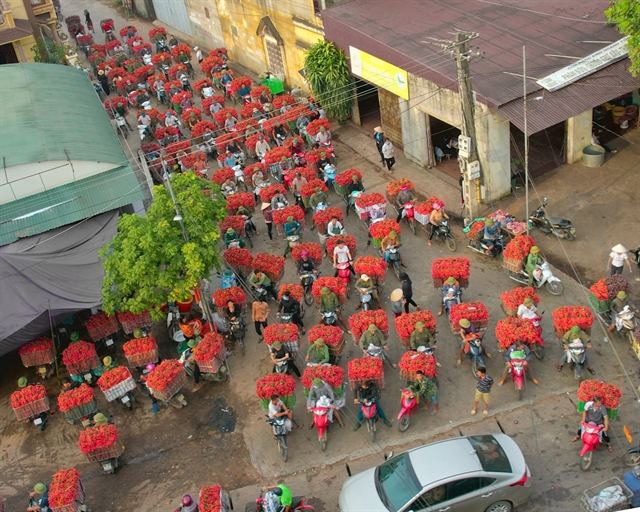 Sunday/Weekend
Sunday/Weekend

Việt Nam is experiencing a surge in cultural tourism, driven by a growing international appetite for heritage and culinary experiences. The trend is particularly embraced by the country's younger generation.
Việt Nam boasts 32 UNESCO world heritage items, including five cultural heritage sites, 24 intangible cultural heritage elements and documentary heritage items, alongside over 40,000 heritage sites, nearly 10,000 of which are classified at the municipal and provincial level.
In recent years, Việt Nam has consistently been highly rated in various international tourism rankings and awards. Việt Nam won the titles of Top Asia Destination and Top Asia Destination for Heritage, Culture and Cuisine by the World Travel Awards (WTA) for three consecutive years from 2018-2020.
The country was again named Top Asia Destination for Heritage, Culture and Cuisine by the WTA in 2023.
 |
| Foreign tourists seen in Hội An ancient town. Photo toquoc.vn |
According to Hà Văn Siêu, deputy director of the Việt Nam National Authority of Tourism (VNAT), when cultural heritage is properly tapped, it provides visitors with a clearer and deeper understanding of local cultural values, making them want to return.
Việt Nam's rich tapestry of traditional crafts, festivals and diverse cuisine is a treasure trove for cultural tourism development. Famous Vietnamese dishes such as phở, bánh mì, bún chả (rice vermicelli with grilled pork and fresh herbs) and bánh cuốn (steamed rolled rice crepes) have been celebrated on prestigious international media channels, becoming ambassadors of Vietnamese tourism.
Việt Nam's world heritage sites have seen a meteoric rise in popularity. Once drawing only a trickle of visitors, the complex of Huế Monuments and Hạ Long Bay, both UNESCO-listed in the 1990s, now welcome millions of visitors annually. Huế attracted 2.28 million in 2023 alone, including over a million foreigners.
Hạ Long Bay's allure is equally potent, with nearly 2.7 million tourists flocking to its waters last year, generating a staggering VNĐ780 billion (US$32.5 million) in revenue, marking an 80 per cent surge from 2022.
Hội An ancient town in the central province of Quảng Nam, another UNESCO heritage gem, has experienced explosive growth since its designation. Visitor number soared to almost four million in 2023, a 99 per cent increase year-on-year, with foreign arrivals tripling to more than three million. Meanwhile, domestic arrivals soared 77 per cent annually to around one million.
 |
| The show 'Tinh Hoa Bắc Bộ' (Quintessence of Tonkin) has been recommended by CNN for tourists visiting Hà Nội. Photo showtinhhoabacbo.com |
Việt Nam's cultural scene is ablaze with captivating shows. Productions like Tinh Hoa Việt Nam (Quintessence of Việt Nam), a grand historical reenactment on Phú Quốc island and Ký Ức Hội An (Memory of Hội An) which transforms Hội An into a nightly entertainment spectacle, have wowed audiences. The latter has even earned the title of Top Entertainment Destination.
Northern Việt Nam's allure is showcased in Vũ Điệu Trên Mây (Dance on the Clouds), a performance that clinched the Top Cultural Tourist Destination award for Sun World Fansipan Legend at the 2022 World Travel Awards. And for those heading to Hà Nội, CNN recommends experiencing the Tinh Hoa Bắc Bộ (Quintessence of Tonkin) show.
As global travellers increasingly seek eco-friendly and heritage-rich experiences, young Vietnamese are stepping up to meet the demand. They are passionate about preserving the national cultural identity, while showcasing it to the world through tourism.
Hà Kim Ngọc, deputy minister of Foreign Affairs and chairman of the Việt Nam National Commission for UNESCO, said while young people already had certain advantages, they needed to harness the power of digital transformation, social media platforms, mobile applications and social networks to introduce and publicise UNESCO heritage sites to a global audience.
He praised young individuals for their bold innovation and creativity which helped open doors to the world, bringing traditional cultural values and the image of Việt Nam to friends across the globe.
"I hope and believe that with the enthusiasm of youth, they will continue to innovate new methods of doing tourism, contributing to exploring the depth of UNESCO heritage sites in Việt Nam as well as promoting the image of Việt Nam and its people more vigorously to friends around the world,” Ngọc said.
Sharing this optimism is Will in Vietnam, a popular TikToker with 3.2 million followers, over 950,000 subscribers on YouTube, and more than 400,000 followers on Facebook. He described Việt Nam as a cultural tourism hub with endless possibilities for exploration.
"Việt Nam has a rich history and tradition with thousands of festivals, numerous historical sites and a diverse geography. There are always new things to explore and learn about. This is one of the reasons why many Europeans flock to Việt Nam to discover its cultural heritage, history and cuisine. I believe Việt Nam should continue to leverage its strengths as a cultural destination," he said.
 |
| An aerial photo of lychee motorbike transporters at the 'Capital of Lychees' in Lục Ngạn District, Bắc Giang Province. Photo courtesy of Khoai Lang Thang |
Popular Vietnamese travel vlogger Khoai Lang Thang said: "Beautiful landscapes might attract tourists to a place once or twice, but when they develop a fondness for the local culture, they will visit more frequently. Integrating culture into tourism is also a way to make culture more accessible, influential and relevant to the times. Therefore, developing tourism that is closely linked to culture also helps preserve our own cultural heritage, deepens love for our homeland and honours the traditions left by our ancestors."
Sùng Mí Phìn, a young Mông ethnic man from the northern mountainous province of Hà Giang, is blending culture with tourism. His homestay business model is a prime example of how locals can preserve and promote their heritage while benefiting from tourism.
"Involving local people in culturally-focused tourism is the best way to respect, preserve and promote traditional cultural values", Phìn said.
Contrary to the concerns of many, young people today are far from indifferent to traditional culture. They are adept at preserving and promoting cultural values through the lens of tourism, turning it into a bridge among ethnic groups.
As Dịu Thị Hương, a Lô Lô ethnic woman and owner of the Cửa Bắc coffee shop in Hà Giang, said: "Only by deeply understanding and appreciating our own ethnic culture can we open up to learning the positive aspects of other cultures, and only then can we truly embrace the 'differences' in the cultures of other ethnic groups."
Expert Vũ Anh Tú from the Cultural Studies Magazine at the Việt Nam National Institute of Culture and Arts Studies asserted that young people’s involvement in cultural tourism aligns perfectly with current trends and holds significance for transmitting and upholding the values of ethnic culture.
This participation also contributes to increasing the diversity and appeal of cultural tourism products. To further develop cultural tourism, Việt Nam must bolster its regulatory framework. In addition to support and incentives, the country needs to strengthen management, inspection and oversight to safeguard ethnic cultural values. Raising public awareness about the effort is also essential for both the general public and tourism industry professionals. VNS




